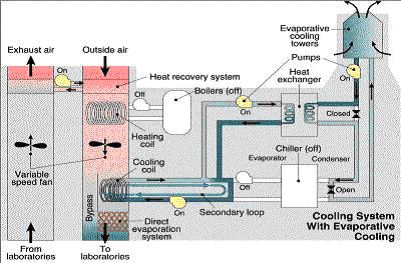
During cool weather, the outside ambient temperature can help save energy in chilled-water systems. The low temperature of the cooling tower water supply enables free cooling of research laboratories, computer rooms, and office buildings. This free cooling is possible if the central plant incorporates a plate-and-frame heat exchanger to provide chilled water production, which means the chiller's compressor can be shut down. Free cooling can be used to save energy whenever the outside wet-bulb temperature drops below the required chilled water set-point. This energy-efficiency measure can save enough compressor electric power to pay for plate-and-frame heat exchanger installation costs in less than two years.

If mechanically generated chilled water is used only to maintain a specified maximum laboratory humidity condition that cannot be achieved with indirect cooling, free-cooling system energy savings will be maximized. The chilled-water supply temperature can be set as a function of outdoor dew point to the highest value that will satisfy the laboratory conditions. The plate-and-frame free-cooling system is operated whenever the chilled-water return temperature is greater than the cooling tower's supply water temperature. This operating strategy maximizes indirect evaporative cooling opportunities and can reduce chiller operation by one-third to one-half.
When chilled-water supply temperatures are raised to save compressor energy and to enable free cooling to operate longer, the laboratory's air handling units (AHUs) will also operate longer or at higher speeds to maintain the required space temperatures. This can lower the energy savings from free cooling or cause an EMCSincrease in energy use. Therefore, monitoring the energy use of the entire chilled water/air handling system with ancan prevent negative energy impact.
Indoor/outdoor free-cooling units designed especially for reliable and cost-effective removal of excess heat in telecom base stations hosting GSM and UMTS networks.
The series of indoor and outdoor free-cooling units is specifically designed to control the internal environment of shelters, cabins or communication enclosures. It is designed to remove excess heat from temperature sensitive electronic equipment where the temperature is required to be maintained within defined limits to achieve optimum performance and to maximize component life.
Free cooling keeps running expenses to a minimum as cooling is provided by fans and ambient air. The products in this series cool without the use of compressors.

Free cooling units
Free cooling units have four standard operation modes (the change between the modes is automatic and follows the temperature).
The Free Cooling units use the ambient air to cool down the room or shelter. In free-cooling mode the external damper will be open and the ambient air will be drawn through the filter by the internal fan and thereby cool the cabin / shelter down. The Free Cooling units are creating an overpressure in the shelter and push the air through the filter and into the cabin. This means that only filtered air enters the room and results in a clean - filtered environment in the cabin. The motorized damper on the opposite side of the cabin will make sure that there will be a low pressuredrop during free cooling.
When the outside air temperature falls to an extremely low level, the Free Cooling unit will start temperature compensation. This means that some of the warm air from the cabin will be mixed with the outside air. This is done to ensure that the intake air into the room is not too cold, and to avoid kuldechok to the hot equipment. This function is not standard on all Free Cooling units.
When the temperature is below the desired set point the external damper will close to protect the shelter from winds from outside and the fans stop.
Heating can be necessary in some areas and therefore some of the Free Cooling units are prepared for connection of an external heating element.
The Free Cooling control unit communicates smoothly with third-party software such as overall surveillance systems that manage alarms and warnings from several base stations.